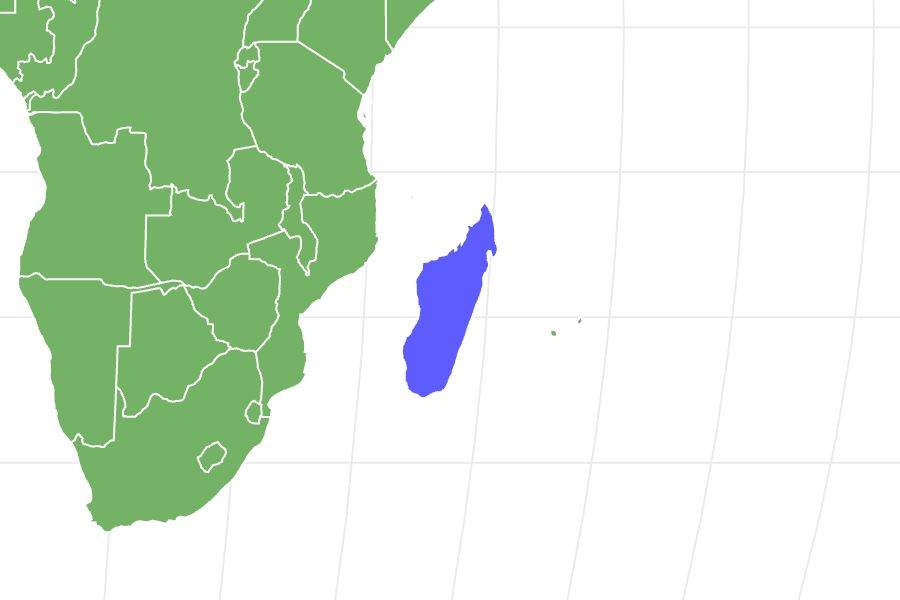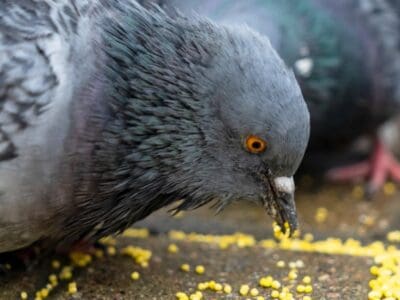Satanic Leaf-Tailed Gecko
Uroplatus phantasticus
They are called “phants” or “satanics” in the pet trade.
Advertisement
Satanic Leaf-Tailed Gecko Scientific Classification
- Kingdom
- Animalia
- Phylum
- Chordata
- Class
- Reptilia
- Order
- Squamata
- Family
- Gekkonidae
- Genus
- Uroplatus
- Scientific Name
- Uroplatus phantasticus
Read our Complete Guide to Classification of Animals.
Satanic Leaf-Tailed Gecko Conservation Status
Satanic Leaf-Tailed Gecko Facts
- Prey
- Insects and small invertebrates
- Name Of Young
- Hatchling
- Group Behavior
- Solitary
- Fun Fact
- They are called “phants” or “satanics” in the pet trade.
- Estimated Population Size
- Unknown
- Biggest Threat
- Habitat loss, illegal pet trade
- Most Distinctive Feature
- Its amazing camouflage
- Other Name(s)
- Eyelash leaf-tailed gecko, phantastic leaf-tailed gecko
- Gestation Period
- 90 to 120 days
- Litter Size
- Two to three per clutch
- Habitat
- Tropical forests
- Predators
- Snakes and rats, perhaps birds
- Diet
- Carnivore
- Type
- Reptile
- Common Name
- Satanic leaf-tailed gecko
- Number Of Species
- 1
- Location
- Madagascar
Satanic Leaf-Tailed Gecko Physical Characteristics
- Color
- Brown
- Tan
- Orange
- Purple
- Skin Type
- Scales
- Weight
- 0.14 to 0.32 ounces; females are heavier
- Length
- 3.5 inches, plus tail
- Age of Sexual Maturity
- 5-6 months
View all of the Satanic Leaf-Tailed Gecko images!
The satanic leaf-tailed gecko’s scientific name translates to “fantastical creature with a flat tail.”
One of the most spectacular examples of camouflage in the animal kingdom, the satanic leaf-tailed gecko looks so much like a dead leaf that a person can be staring at it in a tree and simply not see it. The tail doesn’t just sort of resemble a leaf, it has the veins, discolorations, and flaws of a real decaying leaf. This is important, for this gecko is tiny and lots of Malagasy animals have it on the menu!
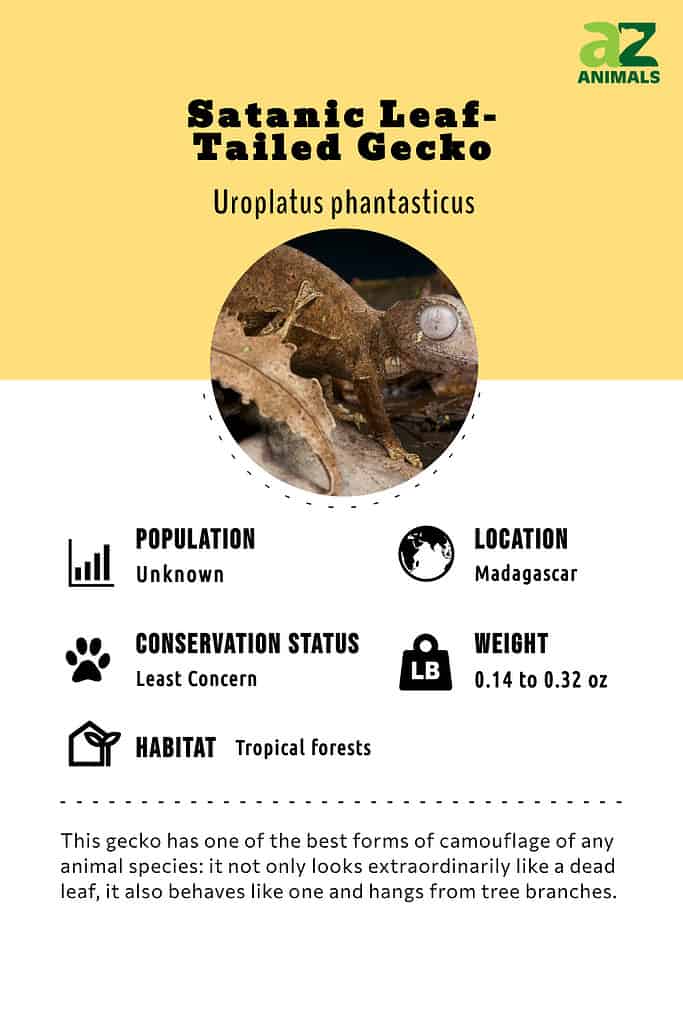
4 Incredible Satanic Leaf-Tailed Gecko Facts
Here are four facts about the satanic leaf-tailed gecko:
- It has a clear membrane over its eyes but no eyelids. To keep its eyeballs clean and moist, the gecko licks them.
- The lizard has a detachable tail that still wriggles even after it’s been detached. This is called autotomy. It does not regrow, leading it to look very similar to the spear-point leaf-tailed gecko.
- These geckos are not only colored like leaves but hang from branches like leaves. They also flatten their bodies against tree trunks with their heads pointing downwards.
- It’s called “satanic” due to the devilish appearance of its pair of pointy ridges over its eyes.

The satanic leaf-tailed gecko has a clear membrane over its eyes but no eyelids.
©reptiles4all/Shutterstock.com
Scientific Name
The satanic leaf-tailed gecko’s scientific name, Uroplatus phantasticus, comes from Latin and Latinized Greek. Uroplatus is derived from the Greek oura, which means “tail,” and platys, which means “flat.” Phantasticus is Latin for “imaginary,” as the reptile has such an otherworldly appearance that the naturalist who named it, George Albert Boulenger, couldn’t believe what he was seeing. So its name means “fantastical creature with a flat tail.” Other common names for this gecko include the eyelash leaf-tailed gecko and the phantastic leaf-tailed gecko.
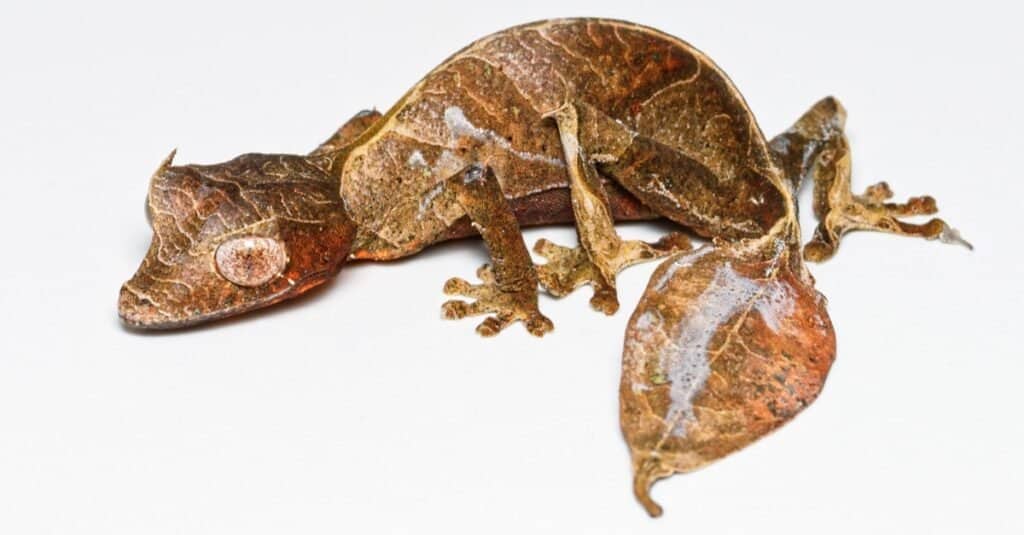
is derived from the Greek
oura, which means “tail,” and
platys, which means “flat.”
©Valt Ahyppo/Shutterstock.com
Evolution and Origins
The satanic leaf-tailed gecko belongs to the Uroplatus genus of geckos referred to as leaf-tail geckos or flat-tailed geckos. There are more than 20 recognized species of Uroplatus geckos, including the common leaf-tail gecko (Uroplatus fimbriatus), mossy leaf-tail gecko (Uroplatus sikorae), and giant leaf-tail gecko (Uroplatus giganteus).
This gecko is one of the most extreme evolutionary examples of an animal adapting to its environment, with its entire body appearing like a leaf that can be found in its habitat, giving it a highly effective form of camouflage from its predators.
Another defense against potential dangers that a close relative of the satanic leaf-tailed gecko evolved is the giant leaf-tailed gecko’s usage of its mouth, opening it to reveal a startling red interior and emitting a screaming sound at the same time.
The ridges, or eyelash-like projections, above the satanic leaf-tailed gecko’s eyes are adaptions that assist it to blend into its environment during the day and at night while hunting.

The satanic leaf-tailed gecko belongs to the
Uroplatusgenus, which includes the giant leaf-tailed gecko.
©Artush/Shutterstock.com
Appearance and Behavior
The satanic leaf-tailed gecko only grows to 3.5 inches long, including its tail, and weighs less than an ounce. Like most geckos, it has huge eyes for nighttime vision, and its feet have bud-shaped toes filled with setae, which allows it to cling to surfaces as smooth as glass.
Its back is arched like the curve of a leaf, and its tail is also foliform, with the spots and irregularities found on a decaying leaf. Males appear to have more notches on their tails than females.
The body of the gecko also bears the colors of a dead or dying leaf, and it has sharp ridges over its eyes that give it a look that some people find satanic.
This little gecko is solitary and spends its days lying flat against, or hanging from, tree branches or tree bark. Because of its shape and coloration, it is hard for predators to see it. At night it starts to hunt for prey.
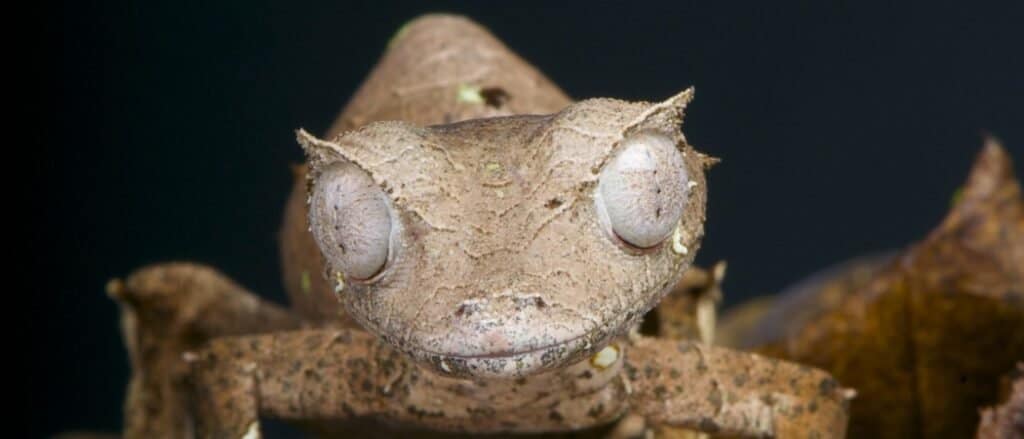
The satanic leaf-tailed gecko has huge eyes to aid nighttime vision.
©iStock.com/reptiles4all
Plant or Animal?
The satanic leaf-tailed gecko is one of several animals that have evolved to look like plants for the purpose of camouflage. The gecko does this not just by its coloration, which has the brown, tan, purple, and orange blotches of a decaying leaf, but by its silhouette, which is irregular for a lizard and allows it to simply disappear into the trees where it lives. The texture of its skin also mimics leaf veins. It can even hang from a tree limb to mimic a leaf.
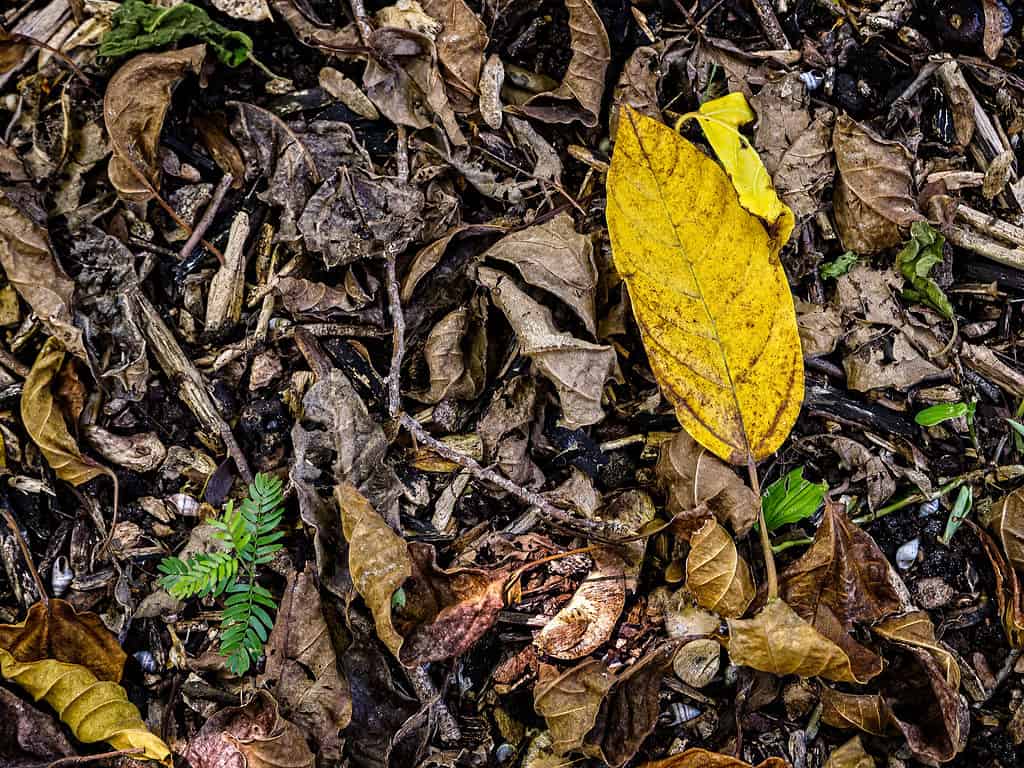
The satanic leaf-tailed gecko evolved to look like a dead leaf to help it camouflage itself.
©iStock.com/Francisco Herrera
Habitat
The satanic leaf-tailed gecko is only found in Madagascar, an island off the continent of Africa. It is found in the rainforests in the center and north of the country. The geckos don’t live very high in the trees but prefer shrubs and small trees a few feet from the ground.
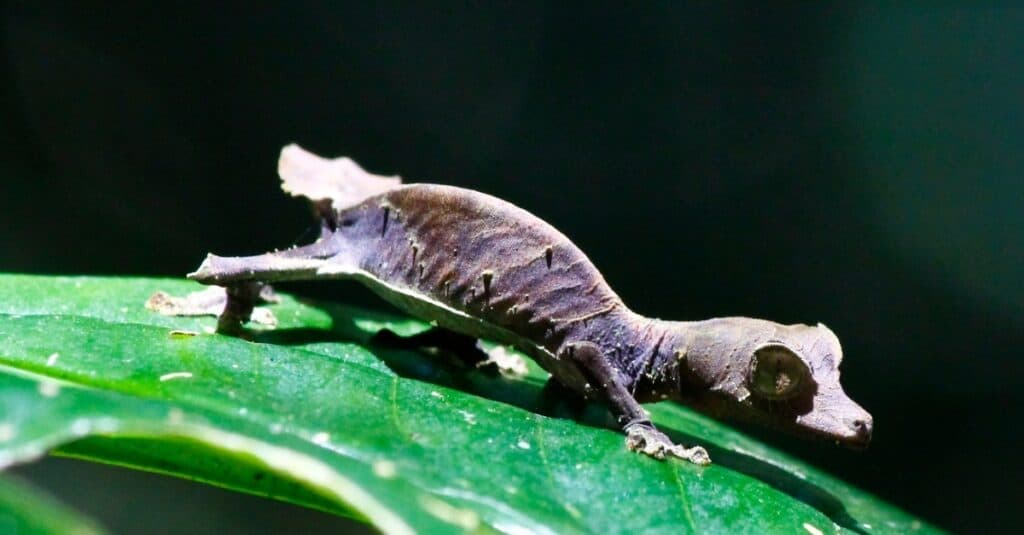
Satanic leaf-tailed geckos are endemic to rainforests in Madagascar.
©iStock.com/dr322
Diet
The diet of this gecko in the wild is believed to be a wide array of insects, small arthropods, and invertebrates. The gecko eats moths, insects, spiders, worms, and snails. Females consume lots of snails, as they need the calcium in their shells for producing eggs. In captivity, these geckos will eat anything they can handle, including crickets, flies, snails, spiders, and cockroaches. They are also dusted with vitamins and calcium.

Female satanic leaf-tailed geckos consume snails for the calcium their shells provide.
©KanphotoSS/Shutterstock.com
Predators and Threats
Predators of the gecko are rats and other, larger reptiles such as snakes. Some biologists also believe that birds prey upon the animal, while others do not.
But the biggest threat to this Malagasy gecko is the destruction of its habitat through logging. It has uniquely evolved to live in its habitat and doesn’t adapt well when it’s disturbed. Geckos that are taken from the wild to be pets also threaten the animal’s ability to thrive.

The biggest threat to this gecko is the destruction of its habitat through logging.
©Jason Patrick Ross/Shutterstock.com
Reproduction and Life Cycle
In the wild, Uroplatus phantasticus starts to breed during the rainy season and will even reproduce in captivity if given the proper care. In the wild, the female lays two to three eggs in leaf litter on the ground. She will lay about six clutches of eggs per year. If the eggs are fertile, they will be hard and round. Infertile eggs tend to be a bit oval and sticky.
The baby lizards hatch after 90 to 120 days and they are tiny replicas of their parents. They are independent and receive no care from either parent. If they’re lucky, they can have a lifespan of over 10 years.

The satanic leaf-tailed gecko’s lifespan can reach more than 10 years.
©iStock.com/reptiles4all
Population and Conservation Status
Though scientists don’t know precisely how many of these geckos are in the wild. There are known populations in Tsaratanana Strict Nature Reserve, Marojejy National Park, and Anjanaharibe Special Reserve. Its conservation status is classified by the International Union for Conservation of Nature (IUCN) as of Least Concern. However, the population is decreasing due to deforestation of its habitat and illegal poaching for the international pet trade.

The IUCN classifies the satanic leaf-tailed gecko as of Least Concern.
©Tobias Arhelger/Shutterstock.com
Satanic Leaf-Tailed Gecko FAQs (Frequently Asked Questions)
Are satanic leaf-tailed geckos carnivores, herbivores, or omnivores?
The satanic leaf-tailed gecko is a carnivore. Specifically, it’s an insectivore whose diet includes insects, worms, spiders and snails.
Why is it called a satanic leaf-tailed gecko?
It was given that name because it has projections over its eyes that make it look like a little devil, and its tail is shaped like a leaf.
What does the satanic leaf-tailed gecko do?
This little gecko rests during the day and hunts at night. It breeds at the beginning of Madagascar’s rainy season.
Are satanic leaf-tailed geckos endangered?
These geckos aren’t yet endangered but they might become so if their habitat continues to be disrupted.
What does the satanic leaf-tailed gecko eat?
The gecko eats insects, including moths and crickets, worms, spiders and snails.
How much is a satanic leaf-tailed gecko?
They cost at least $100 each, and some people pay as much as $400 for a pair.
How much does a satanic leaf-tailed gecko weigh?
On average, it weighs between 0.14 to 0.32 ounces. Females are bigger and heavier than males.
Where is the satanic leaf-tailed gecko found?
This lizard is found only in Madagascar.
How long does the satanic leaf-tailed gecko live?
These lizards can live a surprisingly long time. They’ve been known to have a lifespan of 10 years or more.
Can you touch a satanic leaf-tailed gecko?
You can touch a satanic leaf-tailed gecko, but they should be handled rarely and with care. They really don’t like to be touched.
Thank you for reading! Have some feedback for us? Contact the AZ Animals editorial team.
Sources
- Integrated Taxonomic Information System, Available here: https://www.itis.gov/servlet/SingleRpt/SingleRpt?search_topic=TSN&search_value=819375#null
- MADA Magazine, Available here: https://www.madamagazine.com/en/der-gespenstische-blattschwanz-gecko/
- Wired, Available here: https://www.wired.com/2014/07/absurd-creature-of-the-week-satanic-leaf-tailed-gecko/
- BBC Science Focus, Available here: https://www.sciencefocus.com/nature/what-is-the-satanic-leaf-tailed-gecko/
- Reptiles Magazine, Available here: https://www.reptilesmagazine.com/satanic-leaf-tailed-gecko-care-sheet/
- Uroplatus Information Center, Available here: https://uroplatus.info/uroplatus-phantasticus
- Dallas Zoo, Available here: https://zoohoo.dallaszoo.com/2016/07/12/tiny-tortoise-gecko-hatchlings-are-a-big-deal/

